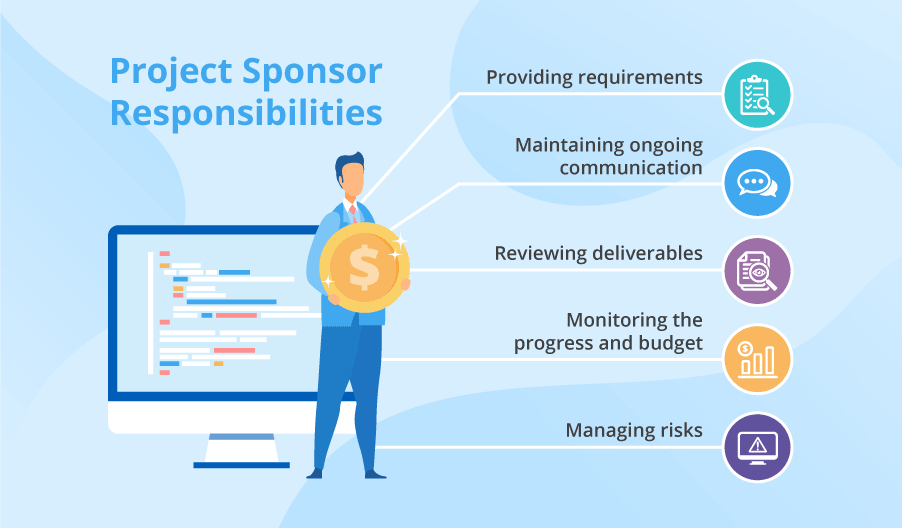Project Sponsor Responsibilities in Software Development
Editor’s note: In this article, Boris, CTO at ScienceSoft, explains how a project sponsor influences the software development process and what responsibilities a project sponsor usually carries out. If you’d like to get an idea of how the cooperation between a project sponsor and an outsourcing vendor can be built, we are glad to share the collaboration to collaboration we follow in our software outsourcing services.
One of my key responsibilities as CTO is driving and maintaining the quality of software development services my company offers. As regards outsourcing projects, I believe, the effective communication of a vendor with the project sponsor is a must-have ingredient to success.
In this article, I’m going to outline project sponsor’s main responsibilities and explain how they influence the entire outsourcing initiative. Note that I refer to project sponsor as a generalized role, which may include one person or several persons (for example, a product owner and a project manager), depending on a business’s specifics and size.

Providing requirements
I always say that project sponsor should monitor the process of business requirements elicitation as this stage directly influences software development costs and time estimation. Thus, project sponsor should review the gathered requirements to ensure they create a realistic scope of work and reflect the needs of the customer to the fullest.
At ScienceSoft, we apply two cooperation models for needs analysis varying in the intensity of project sponsor’s active input.
Option 1: Business analysis on our side
At ScienceSoft, this option is used more often as it reduces customer’s efforts and guarantees the delivery of software that meets a customer’s needs as far as possible. Our business analysts gather information at interviews with the project stakeholders and study the company’s processes and documentation. Then, they perform all-round investigation of the business problems and propose possible IT solutions. Afterwards, they complete and submit a detailed software requirements specification for project sponsor’s approval.
The role of project sponsor here mostly boils down to ensuring access to corporate sources of information (for example, important stakeholders, relevant documents and policies).
Option 2: Business analysis carried out in-house
In some projects, we work with the requirements provided by the customer. If so, project sponsor provides the outline of business needs and reasons for software implementation (it can be created with the help of business analysts). Such outline includes the following sections, usually no more than 20 lines long:
- A statement giving answers to questions such as ‘Who is the customer?’, ‘What are the customer’s needs?’, ‘What is wrong with existing solutions?’, ‘How should software fix it?’
- Stakeholders and their needs.
- Product actors and features. Every actor has 3-6 features; each feature is described in 2-3 lines.
- Up to 6 key quality requirements. All of these should be measurable. For example, “Any web page must open in less than 300 ms” instead of “The website must be fast”.
- Optionally, the vision can be enriched with the details on end users’ preferences, for example, gathered at the meetings with focus groups.
Personally, I wouldn’t recommend this option as it implies much more efforts on the customer’s side. Still, if you already have a detailed vision of your future software and in-house analysts that can be engaged in the project, this may be an approach to consider.
Maintaining ongoing communication
Throughout the project, project sponsor takes part in building and maintaining consistent and ongoing communication, representing the customer and their interests. For example, project sponsor clarifies questions related to the requirements, requests changes when needed and acts as an escalation point for high-level issues, while we as a vendor establish convenient communication environment and tools for it.
Reviewing deliverables
Throughout the software development life cycle, a vendor provides user-related deliverables (such as UI mockups, vertical prototypes, intermediate software versions) and technical deliverables (such as the software architecture, source code, test documentation). project sponsor checks and approves all of these elements, as well as the changes introduced after the customer’s feedback.
I’d also recommend that project sponsor consider hiring one-time independent reviewers to ensure a high-quality review of technical deliverables and prevent rework in the future.
Monitoring the progress and budget
Project sponsor has to check the project’s progress and control the budget to avoid delays and additional expenses. This is especially critical for projects based on the time and material (T&M) payment model, where payment is based on working hours reported by a vendor. To keep the budget on track, PS can request regular reports on the project health and the team’s performance from a vendor’s project manager. At ScienceSoft, for example, such reports include software quality metrics and project metrics.
Managing risks
Project sponsor may take part in risk identification and management along with the project manager on a vendor’s side. In my practice, among risks for a project sponsor to consider were, for example, changes in local industry regulations and unavailability of key managers required as project consultants.
Your foundation of development success
The project outcomes significantly depend on a project sponsor’s involvement, which includes taking part in requirements gathering, answering the vendor’s questions, reviewing interim user-related and technical deliverables, checking the project progress and budget (especially for T&M projects), as well taking part in risk management.
However, my colleagues at ScienceSoft and I are convinced that in any outsourcing initiative, a customer needs to be involved as much as they want to. If an outsourcing partner is mature and self-managed, your participation can get down to reviewing reports and having check-in calls at your convenience. If the approach I described attracts your interest, you are welcome to consider ScienceSoft and turn to our experts to get a consultation on your project.

